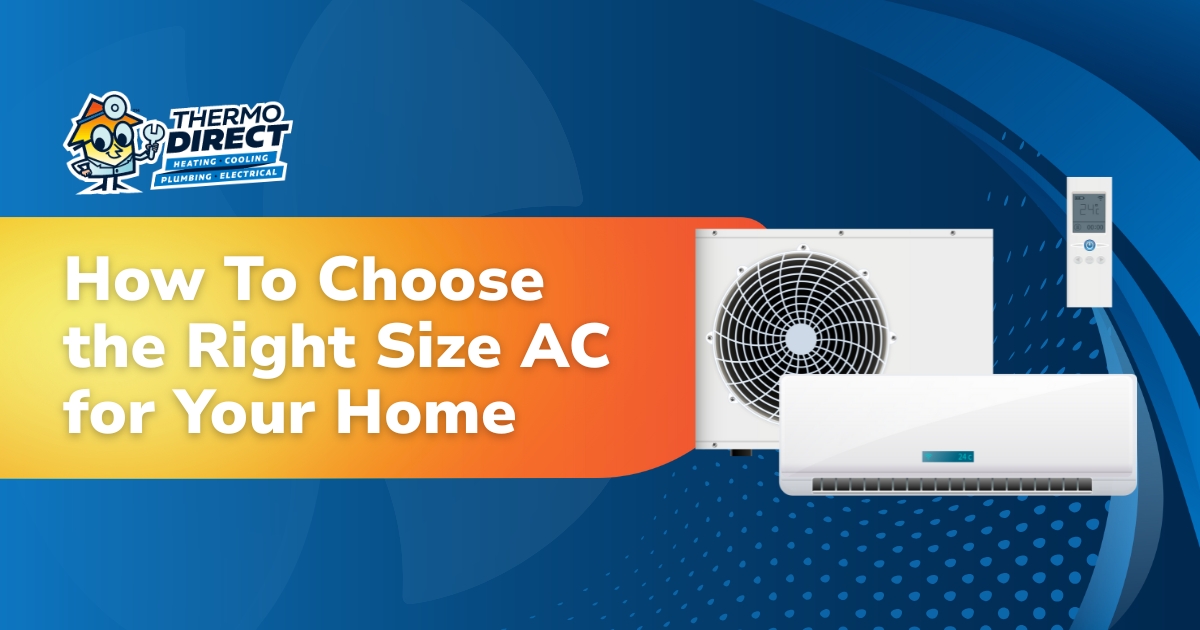When the summer heat sets in, homeowners in Raleigh, NC, depend on their home’s air conditioner to stay comfortable. However, an AC can only do its job effectively if you’ve chosen a system that’s the right size. So, if you’re in the market for a new AC system for your home, it’s helpful to understand what goes into proper AC sizing. Here’s how to choose the right AC size for your home.
What to Know
- Proper AC sizing is essential for improved cooling, efficiency, and system lifespan.
- Home size, insulation, door and window sealing, sun exposure, and heat-producing appliances all impact AC sizing.
- An HVAC professional will perform Manual J calculations to determine the exact size of AC you need.
Why AC Size Matters for Comfort and Efficiency
Many people don’t understand just how essential it is to choose the correct AC unit size for your space. If your system is too small for your home, it will have to work much harder to try to keep it cool, resulting in a shorter AC lifespan and decreased energy efficiency. On the other hand, if your unit is too large, it will cool your home too rapidly, causing the unit to short-cycle and prematurely wear out. For higher AC efficiency, improved comfort, and optimal system lifespan, choosing an AC unit that’s right in the sweet spot between too big and too small is essential.
What Size AC Unit Do I Need for My Home?
What size air conditioner do I need? It’s one of the most common questions we receive when helping homeowners find the right cooling solution for their needs. Before you can select the right size AC for your home, you’ll first need to understand how manufacturers refer to the size of different types of residential HVAC systems. Unlike window air conditioners, which are listed by their BTU output, central air conditioners are measured in tons.
To convert between the two, you only need to do some simple math. You see, one ton is equivalent to 12,000 BTUs. Knowing that makes it easy to understand the sizing scale you’ll find on all central AC systems.
Here in the US, there are five climate zones, each with specific cooling capacity guidelines. Raleigh and Morrisville are part of Zone 2, the second-warmest zone in the US. The following are the air conditioner sizing guidelines for homes within Zone 2.
- 1.5 tons for homes between 600 and 950 square feet.
- 2 tons for homes between 951 and 1250 square feet.
- 2.5 tons for homes between 1251 and 1550 square feet.
- 3 tons for homes between 1501 and 1850 square feet.
- 3.5 tons for homes between 1851 and 2150 square feet.
- 4 tons for homes between 2151 and 2500 square feet.
- 5 tons for homes between 2501 and 3100 square feet.
Since the square footage AC requirements above provide home size ranges for each AC size, you may find that any additions still don’t push you into a larger AC size category. Therefore, this method offers a slightly quicker way for you to estimate your home’s cooling needs.
AC Size Calculator (Raleigh & Morrisville – Zone 2)
Estimate the right central AC size for your home. This quick tool follows Zone 2 guidelines (Raleigh/Morrisville) and adjusts for insulation, sunlight, and ceiling height.
Show Zone 2 quick-reference table
| Home Size (sq ft) | Base Size (tons) | Approx. BTU |
|---|---|---|
| 600–950 | 1.5 | 18,000 |
| 951–1250 | 2.0 | 24,000 |
| 1251–1550 | 2.5 | 30,000 |
| 1501–1850 | 3.0 | 36,000 |
| 1851–2150 | 3.5 | 42,000 |
| 2151–2500 | 4.0 | 48,000 |
| 2501–3100 | 5.0 | 60,000 |
This tool provides a quick estimate only. Final system sizing should be confirmed with a professional Manual J load calculation.
Common Problems When AC Units Are the Wrong Size
Now that we understand the concept of AC sizing a little better, what are the possible consequences of installing an AC that’s the wrong size for your space? Here are a few to keep in mind:
- Uneven cooling in different parts of the home.
- Excessively high energy bills due to short- or long-cycling.
- AC running constantly due to never reaching the set temperature.
- Fluctuating temperature inside the home.
- Increased wear and tear on AC system components.
- Shorter AC lifespan.
- High humidity inside the home.
- Frequent AC breakdowns.
- Loud, unusual noises from the air conditioner.
If you notice any of these signs, there’s a good chance that your air conditioner is not the correct size for your space.
Factors That Impact the Right AC Size
How do you determine what size air conditioner you need? When we talk about how to size an air conditioner, there are several factors that need to be considered:
- Square footage: Your home’s square footage is a major factor in sizing an air conditioner. The bigger your home, the bigger an AC you’ll need.
- Insulation: Insulation determines how well your home maintains its internal temperature and is the second most important factor in AC sizing.
- Door and window sealing: Drafty doors and windows allow cool air to escape and warm air in. An HVAC tech will inspect all entry points and factor their condition into the AC sizing process.
- Sunlight exposure: The amount of sunlight your home gets through windows and skylights plays an important role in determining the cooling power your home needs.
- Heat-producing appliances: Ovens, stoves, dryers, and other appliances that produce heat can affect home cooling when they’re used daily. An HVAC tech will take these appliances (and when they’re used) into consideration for AC sizing.
Why Professional AC Sizing Is Better Than DIY
As our past customers know, there’s no replacement for the professional expertise of a skilled HVAC technician. These experts train to learn the formulas and processes for sizing an AC using a method known as Manual J calculation, which is far more accurate than DIY methods.
Manual J is a guide created by the Air Conditioning Contractors of America (ACCA) that allows for precise calculations of a building’s cooling needs. The formula considers multiple factors independently, then adds them together to arrive at your home’s total heat load.
How Thermo Direct Helps You Choose the Right AC Size
Your Thermo Direct HVAC installer will plug all the data they’ve collected into the Manual J formula, allowing them to find the exact size of AC you need for reliable, efficient cooling. Plus, our team can help you choose a correctly sized unit that meets your energy needs, helping you make sense of SEER ratings and efficiency, and saving you money on your utility bills.
Service Areas – AC Installation Near You
We proudly offer professional AC installation in the following areas:
- Raleigh, NC – 27601, 27603, 27604, 27610
- Durham, NC – 27701, 27703, 27707
- Cary, NC – 27511, 27513, 27519
- Surrounding Wake, Durham, and Orange County communities
Call Today for Expert AC Installation in Raleigh, NC
If you’re ready to stop the guesswork and get an air conditioner that’s perfectly suited to your space, Thermo Direct has you covered. Our technicians will help you breeze through the AC sizing process, ensuring high efficiency, superior comfort, and a longer system lifespan. Contact us today to schedule your AC sizing and installation service!
Frequently Asked Questions
What happens if my AC unit is too big for my home?
Oversized ACs tend to short-cycle, causing premature breakdowns and energy efficiency issues.
What problems occur with an undersized air conditioner?
Undersized air conditioners often operate in a long cycle or fail to shut off, as they struggle to keep the entire space cool. This shortens their lifespan and consumes energy inefficiently.
How many BTUs do I need to cool a 1,500 sq ft home?
A 1,500 sq. ft. home requires approximately 34,000 BTUs, but this varies depending on other factors like insulation, ceiling height, window sealing, and more.
How do SEER ratings factor into choosing the right AC size?
Seasonal energy efficiency ratio (SEER) ratings are a separate consideration from AC size, as they determine energy efficiency, not cooling power. A properly sized AC with a high SEER rating will offer the best cooling and efficiency.










